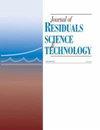生活污水三段式串联快速渗透系统去除有机物的机理研究
引用次数: 1
摘要
以某校园生活污水为研究对象,研究了三级串联构建快速渗透(CRI)处理系统对化学需氧量(COD)的去除效果及其机理。实验结果表明,三级串联CRI系统的COD去除率为79.65%,比常规CRI系统提高了6%。三级串联CRI系统出水水质达到《城市污水处理厂污染物排放标准》(GB18918-2002)的一级A标准。在系统的第一个隔间中,废水中的总有机物和颗粒有机物分别被去除54%和83%。好氧氨化菌数量沿系统各隔间自上而下递减,明显高于常规CRI系统。脱氢酶活性呈m型变化规律,存在两个峰值。COD去除率与好氧菌数量呈极显著相关(相关系数r = 0.97),与脱氢酶活性呈极显著相关(r = 0.64)。生物膜质量和活性生物膜质量呈m型变化,明显高于常规CRI系统。COD去除率与活性生物膜质量的相关性较显著(r = 0.73)。本文章由计算机程序翻译,如有差异,请以英文原文为准。
A Study on Mechanism of Organic Matter Removal in a Three-step Series Constructed Rapid Infiltration System Used for Domestic Wastewater Treatment
This study focused on domestic wastewater in a campus and investigated chemical oxygen demand (COD) removal efficiency and removal mechanism in a wastewater treatment system using three-step series constructed rapid infiltration (CRI). The experimental results indicated that the three-step series CRI system led to COD removal of 79.65%, a value 6% greater than that in a system using conventional CRI. Moreover, the effluent water quality of the three-step series CRI system met the first level criteria A as specified in Discharge Standard of Pollutants for Municipal Wastewater Treatment Plant (GB18918-2002). Total organic matter and particulate organic matter in the wastewater were removed in the first compartment of the system by 54% and 83%, respectively. The quantity of aerobic ammonifying bacteria decreased from top to bottom along the compartments in the system, and was obviously higher than in the conventional CRI system. The dehydrogenase activity showed an M-shaped variation pattern in which two peak activity values were observed. The COD removal efficiency showed a very significant correlation with the aerobic bacteria quantity (correlation coefficient r = 0.97), and showed a relatively significant correlation with the dehydrogenase activity (r = 0.64). The biofilm mass and the active biofilm mass showed M-shaped variation patterns, and were obviously higher than in the conventional CRI system. The COD removal efficiency showed a relatively significant correlation with the weight of the active biofilm mass (r = 0.73).
求助全文
通过发布文献求助,成功后即可免费获取论文全文。
去求助
来源期刊

Journal of Residuals Science & Technology
环境科学-工程:环境
自引率
0.00%
发文量
0
审稿时长
>36 weeks
期刊介绍:
The international Journal of Residuals Science & Technology (JRST) is a blind-refereed quarterly devoted to conscientious analysis and commentary regarding significant environmental sciences-oriented research and technical management of residuals in the environment. The journal provides a forum for scientific investigations addressing contamination within environmental media of air, water, soil, and biota and also offers studies exploring source, fate, transport, and ecological effects of environmental contamination.
 求助内容:
求助内容: 应助结果提醒方式:
应助结果提醒方式:


